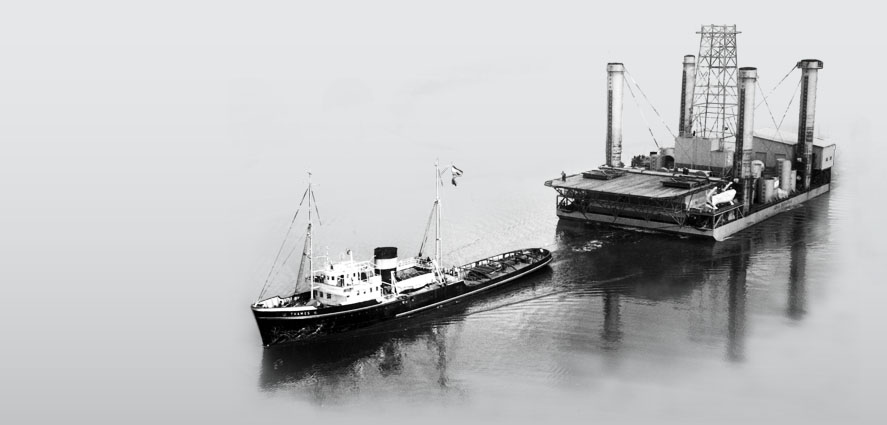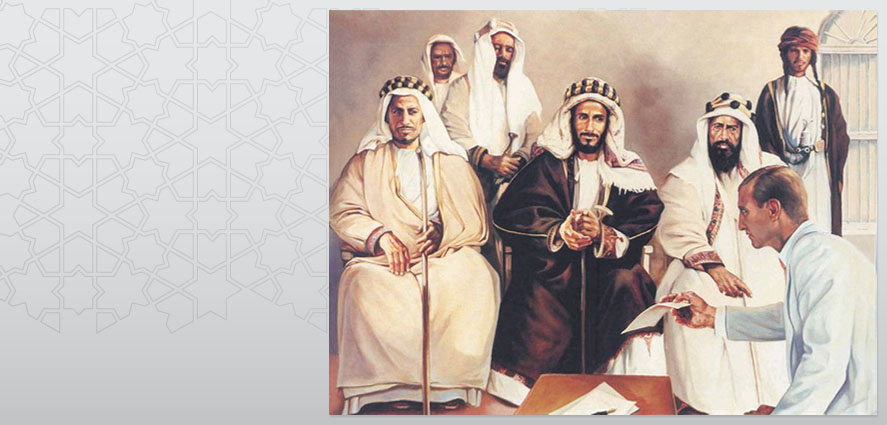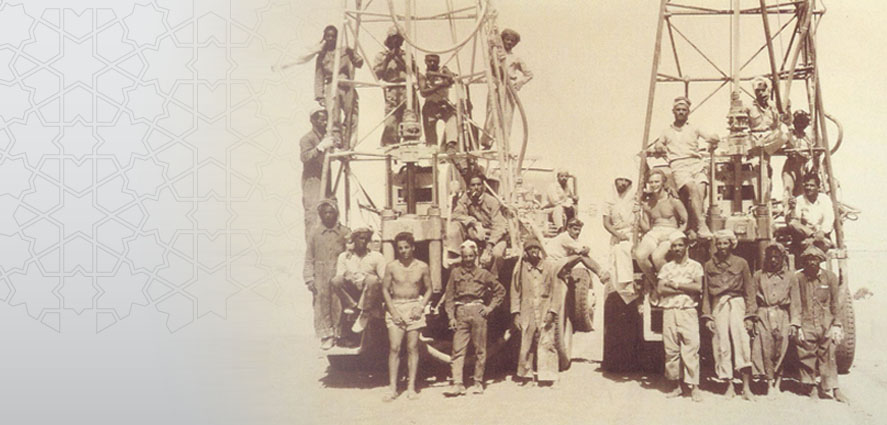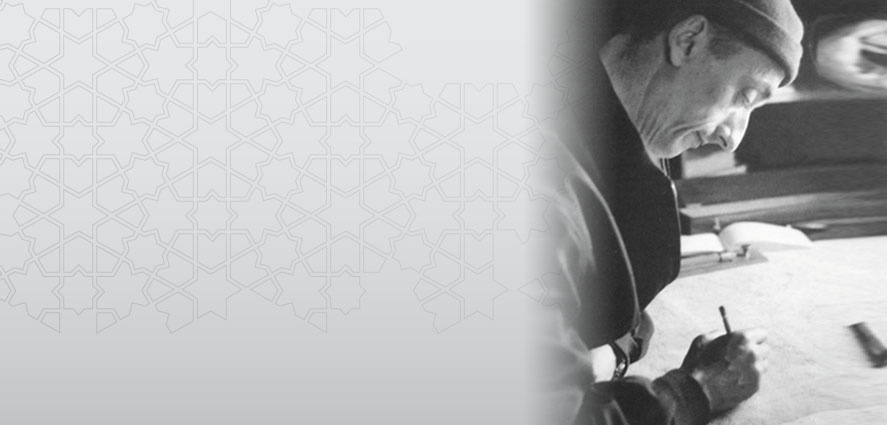
You are in :
Oil & Natural Gas History

The Long March To Modernity
The story of the Abu Dhabi oil industry mirrors the recent history both of the Emirate and of the UAE. It involved an eventful and fascinating journey with a long and sometimes difficult early history. Approximately twenty years elapsed between the signing of the first oil concession and the discovery of oil in commercial quantities. Even after oil was discovered, the immediate impact and benefits to the citizens of Abu Dhabi were quite limited. It was only after 1966 that the oil wealth was first deployed to begin the transformation of Abu Dhabi into a modern state and later, in 1971, to support the formation of the UAE. This journey required endurance and commitment with significant milestones and obstacles along the road.
Riches From the Sea

After the Second World War, the development of new drilling techniques allowed deeper offshore waters to be explored. In 1949, the Rulers of the Emirates promoted their claim to a portion of the continental shelf in the Arabian Gulf. However, IPC claimed that their 1939 concession also covered these offshore waters. Regardless, Sheikh Shakhbut signed an agreement with the Superior Oil Company, a British-Canadian firm, covering the whole of Abu Dhabi's continental shelf. IPC protested and the issue was referred to arbitration.
An international tribunal in Paris in August 1951 attended by the Ruler and Sheikh Zayed decided that Sheikh Shakhbut had acted legally in granting the 1950 concession, which was subsequently validated.
On 9 March 1953, Sheikh Shakhbut signed a new concession with the D'Arcy Exploration Company, a subsidiary of British Petroleum, covering 30,370 square kilometres of seabed on Abu Dhabi's continental shelf. In 1955, this was assigned to a new company, Abu Dhabi Marine Areas Ltd. (ADMA), two-thirds owned by BP and one-third by Compagnie Francaises des Petroles (CFP), now known as TOTAL.
Early Days

In the 1920s, the Rulers of the Trucial States, then in 'special treaty relations' with Britain, had signed agreements committing themselves to oil exploration exclusively with companies approved by the British Government. In January 1939, the first Abu Dhabi oil concession was signed by the then Ruler, Sheikh Shakhbut bin Sultan Al Nahyan.
The 75-year agreement was signed with the Iraq Petroleum Company (IPC), a consortium that included two British-based companies, as well as firms from the United States and France. It was subsequently allocated to an IPC subsidiary, Petroleum Development (Trucial Coast) [PD(TC)].
Painful Delays

IPC had already carried out small-scale geological surveys in the mid-1930s. However, the Second World War brought a halt to exploration, which was not to resume until 1946. This delay was unfortunate as a new source of income was desperately needed by the Ruler and his citizens. The collapse of the pearling industry in the 1930s caused great economic hardship and during the war years, malnutrition and disease ravaged local communities.
The Quest Begins
In February 1950, PD(TC) spudded the UAE's first oil well at Ra's Sadr to the north-east of Abu Dhabi City. This was the deepest well drilled in the Middle East so far. However, it proved to be dry and efforts were diverted to another well at Jebel Ali in Dubai, which also failed.
PD(TC) then returned to Abu Dhabi, carrying out seismic work near Mirfa and establishing a base camp at Tarif in 1952. The Murban-1 well drilled between 1953 and 1954 was also unsuccessful. Further seismic work was undertaken onshore and offshore from 1953–1957 with more unsuccessful wells being drilled at Jazira, Sabkha Matti and Shuweihat.
A second well was drilled at Murban in 1958, which although unsuccessful, provided encouraging signs of hydrocarbons and in 1959 the Murban-3 well was drilled. After 5 consecutive failures, this was a success and in late 1960, PD(TC) informed the Ruler that oil had been found in commercial quantities. The field was re-named Bab and work began on developing the oil field with a pipeline and terminal at Jebel Dhanna. In December 1963, a tanker with the first cargo of oil from the Bab field set sail and Abu Dhabi officially became an oil producer that would grow to attain global stature.
Visionary Leadership and Investment

With oil revenues flowing, albeit slowly at first, the demands from a long-suffering population for rapid socio-economic development became overwhelming. This required progressive and visionary leadership with a focus on the future investment of new-found wealth. On 6 August 1966, the ruling Al Nahyan family decided that the time had come for Sheikh Shakhbut to step down and for his younger brother, the highly respected Sheikh Zayed, to take his place. This change of leadership marked a new dawn in Abu Dhabi's development and the historic era of modernisation had begun. During Sheikh Zayed's first years in power, roads were constructed, electricity was installed, hospitals and schools were built along with Abu Dhabi's first port and airport, and government departments were established, as a modern, dynamic city and Emirate began to emerge. These changes transformed the quality of life for countless citizens and would accelerate and diversify in the decades ahead.
Cousteau's Surveys

In the mid-1950s, the research ship Calypso sailed into the warm waters of the Gulf and conducted seabed studies under the direction of the world-famous French explorer, Jacques-Yves Cousteau. These surveys identified the old pearl bank of Umm Shaif as a possible area for oil exploration. As a result of these surveys, in 1957 a drilling rig, ADMA Enterprise, was constructed in Germany and slowly towed to the Gulf, where the Umm Shaif-1 well was spudded in January 1958 as the first offshore well in the Emirate. This first well produced nearly 4,500 barrels of oil per day and ADMA realised that Umm Shaif was a hugely significant oil field. Further wells were quickly drilled and a pipeline laid to Das Island, enabling the first export shipment of Abu Dhabi crude oil in 1962. In the following year, an even bigger offshore field was discovered to the south-east of Das known as the Zakum field. In 1996, 1 year before his death, Cousteau received a special award from Sheikh Zayed to acknowledge his contributions to the fortunes of Abu Dhabi.
History of Oil in Abu Dhabi

















